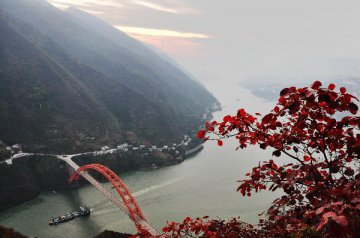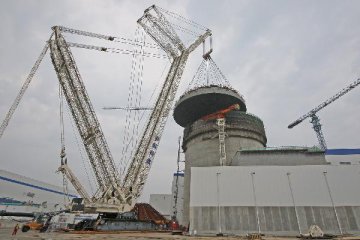
Draft 2016-2020 nuclear development plan takes shape
China's 13th Five-Year (2016-2020) Development Plan for nuclear power industry drafted by the National Energy Administration (NEA) and other industry authorities has taken shape, and is now open to comments from industrial experts and companies.
According to the Mid- and Long-term Development Plan for Nuclear Power Industry (2011-2020) and the Action Plan for Energy Development Strategy (2014-2020), China targets to have 58 million kilowatts of nuclear power installed capacity operational and 30 million kilowatts under construction by 2020. Meanwhile, nuclear power output is expected to weigh 4 percent in China's total power output.
If the 13th Five-Year (2016-2020) Development Plan for nuclear power industry did not lower down the development target, five or six nuclear power generating units are expected to start construction annually in 2016-2020, according to a report by Shanghai Securities New citing an expert with China Nuclear Energy Association.
Li Ganjie, head of National Nuclear Safety Administration, even expects 6-8 nuclear power generating units to start construction annually in 2016-2020.
So far, China has put into operation 27 nuclear power generating units with total installed capacity of 25.77 million kilowatts, and is constructing 25 more units with total installed capacity of 27.5 million kilowatts.
By the end of 2020, total nuclear power generating units, including operational and under construction ones, may top 90 units with combined installed capacity approximating to 90 million kilowatts, said Li Ganjie.
Table 1. Operational nuclear power generating units in China
|
Power Plant and Location |
Generating Unit |
Year of operation |
Installed capacity (Unit: million kilowatts) |
|
Qinshan Nuclear Power Plant, Zhejiang province |
No. 1 |
1994 |
0.31 |
|
Qinshan Nuclear Power Plant, Phase II, Zhejiang province |
No. 1 |
2002 |
0.65 |
|
No. 2 |
2004 |
0.65 |
|
|
No. 3 |
2010 |
0.66 |
|
|
No. 4 |
2011 |
0.66 |
|
|
Qinshan Nuclear Power Plant, Phase IIi, Zhejiang province |
No. 1 |
2002 |
0.728 |
|
No. 2 |
2003 |
0.728 |
|
|
Tianwan Nuclear Power Plant, Phase I, Jiangsu province |
No. 1 |
2007 |
1.06 |
|
No. 2 |
2007 |
1.06 |
|
|
Fangjiashan Nuclear Power Plant, Zhejiang Province |
No. 1 |
2014 |
1.089 |
|
No. 2 |
2015 |
1.089 |
|
|
Hongyanghe Nuclear Power Plant, Liaoning province |
No. 1 |
2013 |
1.11879 |
|
No. 2 |
2014 |
1.11879 |
|
|
No. 3 |
2015 |
1.11879 |
|
|
Yangjiang Nuclear Power Plant, Guangdong province |
No. 1 |
2014 |
1.086 |
|
No. 2 |
2015 |
1.086 |
|
|
Dayawan Nuclear Power Plant, Guangdong province |
No. 1 |
2002 |
0.984 |
|
No. 2 |
2002 |
0.984 |
|
|
Ling'ao Nuclear Power Plant, Phase I, Guangdong province Phase II |
No. 1 |
2002 |
0.99 |
|
No. 2 |
2003 |
0.99 |
|
|
No. 3 |
2010 |
1.086 |
|
|
No. 4 |
2011 |
1.086 |
|
|
Ningde Nuclear Power Plant, Fujian province |
No. 1 |
2013 |
1.089 |
|
No. 2 |
2014 |
1.089 |
|
|
No. 3 |
2015 |
1.089 |
|
|
Fuqing Nuclear Power Plant, Fujian province |
No. 1 |
2014 |
1.089 |
|
No. 2 |
2015 |
1.089 |
|
|
TOTAL |
27 units |
25.77737 |
Table 2. Nuclear power generating units under construction in China
|
Power Plant and Location |
Generating Unit |
Designed installed capacity (Unit: million kilowatts) |
|
Hongyanghe Nuclear Power Plant, Liaoning province |
No. 4 |
1.11879 |
|
No. 5 |
1.11879 |
|
|
No. 6 |
1.11879 |
|
|
Taishan Nuclear Power Plant, Phase I, Guangdong province |
No. 1 |
1.75 |
|
No. 2 |
1.75 |
|
|
Yangjiang Nuclear Power Plant, Guangdong province |
No. 3 |
1.086 |
|
No. 4 |
1.086 |
|
|
No. 5 |
1.086 |
|
|
No. 6 |
1.086 |
|
|
Ningde Nuclear Power Plant, Fujian province |
No. 4 |
1.089 |
|
Fangchenggang Nuclear Power Plant, Phase I, Guangxi Zhuang Automous Region |
No. 1 |
1.08 |
|
No. 2 |
1.08 |
|
|
Fuqing Nuclear Power Plant, Fujian province |
No. 3 |
1.089 |
|
No. 4 |
1.089 |
|
|
No. 5 |
1.089 |
|
|
No. 6 |
1.089 |
|
|
Sanmen Nuclear Power Plant, Guangdong province |
No. 1 |
1.25 |
|
No. 2 |
1.25 |
|
|
Changjiang Nuclear Power Plant, Phase I, Hainan province |
No. 1 |
0.65 |
|
No. 2 |
0.65 |
|
|
Tianwan Nuclear Power Plant, Phase II, Jiangsu province |
No. 3 |
1.1 |
|
No. 4 |
1.1 |
|
|
Haiyang Nuclear Power Plant, Phase I, Shandong province |
No. 1 |
1.25 |
|
No. 2 |
1.25 |
|
|
Shidaowan Nuclear Power Plant, Demon project, Shandong province |
No. 1 |
0.2 |
|
TOTAL |
25 units |
27.50537 |
The draft 13th Five-Year (2016-2020) Development Plan for nuclear power industry also puts up to increase China's total nuclear power installed capacity to 120-150 million kilowatts and the proportion of nuclear power output to 8-10 percent in total power output of the country by 2030, indicating that nuclear power would be a major force for promoting non-fossil energy power generation in long term.
-- Momentum is gathering on restart of inland nuclear power projects
Construction on inland nuclear power projects is likely to restart in the following five years. The National Development and Reform Commission has filed a research report on developing inland nuclear power projects to the State Council according to the positive result of the comprehensive argument conducted by Chinese Academy of Engineering and China Nuclear Energy, according to a report by Economic Information Daily.
Over ten provinces have made plans for nuclear power projects, with 31 proposals having already passed the initial feasibility test.
After the Fukushima nuclear accident in 2011, Chinese government decided not to approval new inland nuclear power projects in 2011-2015, and many inland nuclear power projects were halted ever since, including the Taohuajiang project in Hunan, the Pengze project in Jiangxi, and the Dafan project in Hubei. By the end of 2013, investment in the Taohuajiang project hit 4.63 billion yuan, and that in the Pengze project and the Dafan project both topped 3.4 billion yuan.
Actually, the safety of inland nuclear power plants would be guaranteed as long as strictly adhering to regulations and discharge standards," said Su Gang, a senior engineer with China Nuclear Power Engineering Co. Ltd.
Meanwhile, China has set stricter standard for liquid discharge of inland nuclear power plants, and current technology would not create pollution or disturb the water resource distribution and water safety at the location of inland nuclear power plants, said Su Gang.
The rapid economic growth of inland provinces means the area will need more power, and China should develop inland nuclear power projects to meet rising total and per capita energy consumption, according to a research report from Chinese Academy of Engineering.
Three inland nuclear power plants in central China's Hunan, Hubei and Jiangxi provinces are likely to be the first projects to resume construction, according to an industry insider, who spoke on condition of anonymity.
An insider with NEA earlier noted that China would primarily develop nuclear power projects in east coastal areas in 2016-2020, and moderately develop one or two projects in Central China.
-- "Belt and Road Initiative" to push up development of nuke equipment manufacturing
Apart from the pressure of achieving development target for 2020, China's nuclear power equipment manufacturing industry is expected to see rapid development in 2016-2020 thanks to increasing overseas demand under the influence of "the Belt and Road Initiative".
While developing nuclear power projects in the domestic market, China is stepping up overseas projects and global cooperation to export its advanced equipment.
China General Nuclear Power Corp. (CGN) inked a memorandum of understanding (MOU) with Kenya Nuclear Power Bureau on cooperative projects in the African nation in September, marking another milestone for China's nuclear power overseas strategy following other collaboration agreements including one signed with Pakistan in August.
China is also pursuing nuclear deal with UK. In October, Chinese and French companies signed an agreement on developing British nuclear projects. According to the deal, one of the projects will use HPR1000, a technological system developed by China, after it passes assessment by British regulators.
Currently, more than 40 countries are considering developing nuclear power generation, and the potential large overseas market would drive faster development and exports of Chinese nuclear power technology.
Meanwhile, the 13th Five-year Plan for nuclear energy power generation puts up to focus on core issues such as increasing domestic supply of native uranium, development of nuclear fuel recycling, and localization of equipment supply. An industry analyst said that it usually takes 8 to 10 years to complete building of a nuclear power plant and the 13th Five-year Plan for the industry has to set up a mid- and long-term nuclear power generation target in advance. Since the construction of key equipment, such as primary nuclear pump and steam generator, takes long time, the demand for nuclear equipment supply chain is likely to rise considerably along with growing installed nuclear capacity.
























Latest comments